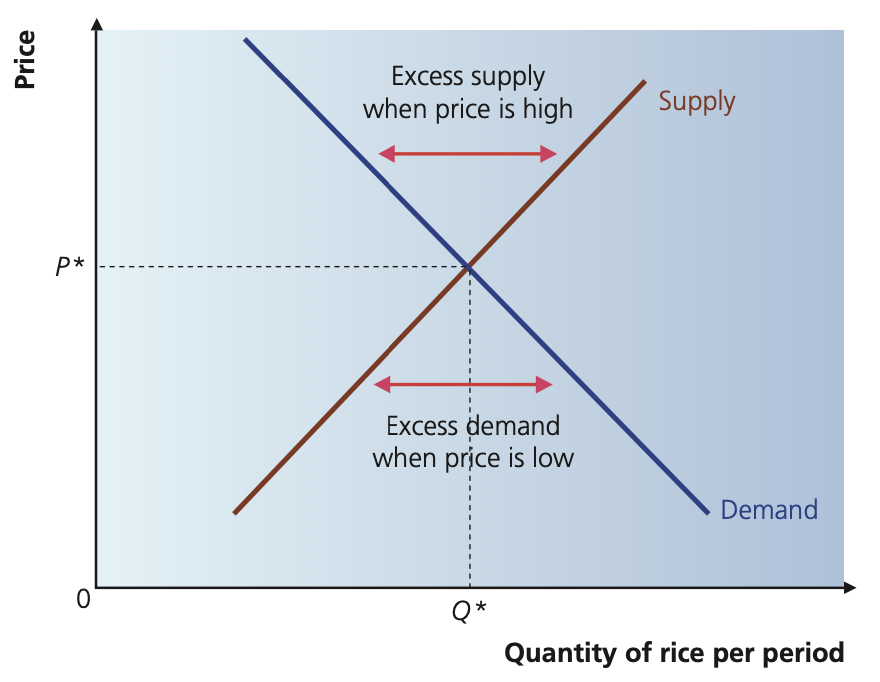Market Equilibrium and Forces (copy)
1/15
Earn XP
Description and Tags
Name | Mastery | Learn | Test | Matching | Spaced |
|---|
No study sessions yet.
16 Terms
What does it mean when a market is at equlibrium?
For a given price, the quantity supplied and quantity demand are the same.
What are the 2 case of market disequilibrium?
Surplus (excess supply) QS > QD
Shortage (excess demand) QD > QS
In a supply and demand graph, which part represents equilibrium and which part disequilibrium (and what kind of disequilibrium)
Bottom is shortage, top is surplus. Intersection is equilibrium.

How does a market surplus go back to the equilibrium?
When there is surplus, suppliers are producing more than what the consumers demand.
They will have excess stock to get rid off, and hence are incentivised to lower prices to clear stock. Prices drop.
Consumers see the prices going down, and hence are incentivised to buy more. Demand expands.
The prices and quantity will move to towards the equilibrium, where there is allocative efficiency.
How does a market shortage go back to the equilibrium?
When there is shortage, consumers are demanding more than what the suppliers are supplying
To get enough of what they need, consumers are incentivised to pay more. Prices rise.
Suppliers see the rising prices, and hence are incentivised to supply more. Supply expands.
The prices and quantity will move to towards the equilibrium, where there is allocative efficiency.
Think about the various ways supply and demand curves can shift in relation to each other, and what happens to the equilibrium price.
Think of the graph. Uncertain means it depends on how much DD and SS shifted.

What is alternative/competitive demand?
Alternative demand is demand that arises for a good when there is a change in price for its substitute.
What is joint demand?
Joint demand is the demand that arises for a good when the price of its complement changes.
What is derived demand?
Derived demand is when the demand for the good or factor of production is does not arise because of the it per-se, but on what the goods/services it can provide.
The demand can be derived from many different needs.
Examples of things with derived demands:
Labour (ppl want the service provided, not the people per-se)
Currency (ppl want to buy stuff with the money, not the money per-se)
What is joint supply?
When more than one good is being supplied together. Perhaps one is a by-product of another.
Example: beef and leather.
What functions does the price mechanism, play?
A.R.S.I
They help achieve allocative efficiency
Ration scarce resources
Signal whether there is a shortage of surplus
Incentivise consumers and producers to demand/supply more/less
During a shortage, what does the price mechanism do?
During a shortage, consumers will pay more to get the quantity demanded. There is an upwards pressure on price.
This signals to the producers that there is a shortage and the higher price incentivises producers to supply more to meet demand.
Higher prices ration scarce resources by limiting the goods to only those who are willing and able to buy it at this higher price. It de-incentivises some people to buy the good.
All this will happen until the market is at equilibrium again. Allocative efficiency
During a surplus, what does the rice mechanism do?
During a surplus, producers will want to clear their unsold stock, by lowering prices. There is a downwards pressure on price.
This signals to the consumer that there has been a surplus and the lower price incentivises consumers to buy more of the good.
Scarce resources are rationed as lower prices encourage more demand (so the extra stock isn’t wasted.)
All this will happen until the market is at equilibrium again. Allocative efficiency
How can consumers express their preferences between alternative goods so that producers can produce the best mix of goods and services?
Through prices. (Prices signal!)
What is allocative efficiency?
When you cannot increase the welfare of one person without decreasing the welfare of another.
This happends when producers produce just enough to meet the demands of consumers. Scarce resources are allocated efficiently.
What are some downsides of the price mechanism?
The rationing function means that people with more income can bid higher for goods, potentially influencing the market in a way that is not beneficial to other consumers.
Price mechanism, while being able to guide things to allocative efficiency, doesnt care if they are allocated relative to what is socially most desirable. The price mechanism holds no idea on what benefits the society.